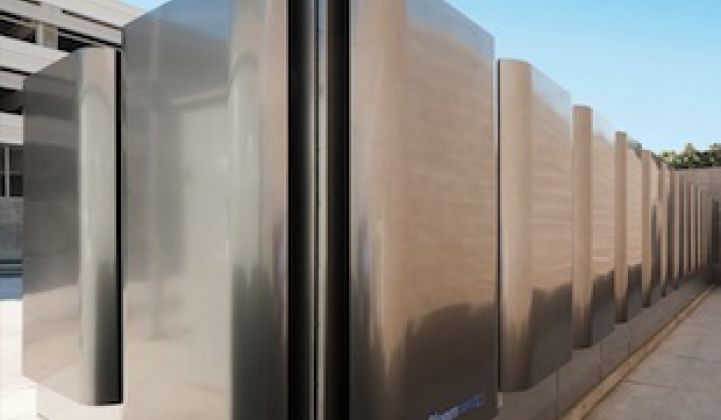Fuel cell "startup" Bloom Energy just raised $130 million more in venture capital, according to a scoop from Fortune.
That takes the VC funding to beyond $1.1 billion for this firm and makes it one of the all-time leaders in VC funding. Along with Fisker and Solyndra -- not exactly great company.
According to Fortune, the first $100 million came from an unidentified new investor and $30 million came from Credit Suisse -- while existing investors did not participate. This funding was structured as an "extension to the company's Series G round that originally closed on $150 million in 2011 at a $2.7 billion pre-money valuation," as per Fortune. Existing investors include KPCB, NEA, Advanced Equities, Goldman Sachs, and DAG.
Bloom Energy had $101 million in pro forma Q3 2012 revenue alone. And Bloom suggests it will turn a profit, according to Dan Primack of Fortune. Bloom's valuation dwarfs the collective market cap of the public fuel cell firms and its revenue is greater than the collective revenue of those firms. A Bloom board member has spoken of an IPO this year or next.
After raising more than $1.1 billion in venture capital over a decade from investors including GSV Capital, Apex Venture Partners, DAG Ventures, Kleiner Perkins Caufield & Byers, Mobius Venture Capital, Madrone Capital, New Enterprise Associates, SunBridge Partners, Advanced Equities, and Goldman Sachs, this could be the year.
According to an investor letter cited by Dan Primack of Fortune, the firm's cost of goods was $106 million, along with $26 million in operating expenses. That's a loss of $42 million on a GAAP basis, along with a net cash loss of $80 million in the quarter. However, those Q3 numbers are hobbled by an inventory and timing issue, and cash burn dropped 56 percent between Q2 and Q3, according to Primack. The firm had a 26 percent quarter-over-quarter revenue increase.
Bloom CFO Bill Kurtz told Fortune in an official statement: "Bloom Energy is pleased with the substantial progress we have made in 2012. On a pro-forma basis, Bloom has become gross-margin-positive in 2012 and is on track with our goal to be profitable in 2013." The claim from Bloom's CFO suggests that Bloom is finally making money on every fuel cell it ships.
Bloom builds fuel cells of the solid-oxide variety with natural gas as the fuel. There is no heat resource in the Bloom Box as in other CHP fuel cells.The 200-kilowatt units are intended for commercial and industrial applications, and the firm boasts an all-star list of customers, including Adobe, FedEx, Staples, Google, Coca-Cola, and Wal-Mart.
In 2012, Bloom raised $100 million of a potential $150 million from Apex Venture Partners and an undisclosed firm. (Jeff St. John of GTM reports on Bloom's valuation and stock sales in the secondary market.)
SiliconBeat reports that Santa Clara Valley's Transportation Authority will get $750,000 in federal funds to help finance a 400-kilowatt Bloom Energy fuel cell facility at a total cost of $4 million. Using the numbers supplied, that works out to $10,000 per kilowatt, which sounds about right for a Bloom Box, although a bit high for a competitive power source.
Bloom's fuel -- natural gas -- is a commodity and subject to price increases. Bloom's business has relied on state subsidies for distributed energy, but subsidies expire. The long-term reliability of the fuel cell stack remains a risk, and some have doubted Bloom's green claims and employment practices.
But in today's difficult cleantech business climate, those profit noises from the CFO are cause for cautious optimism. If Bloom is actually profitable in 2013, the company would be a testament to the viability of capital-intensive, VC-funded cleaner energy breakthroughs and the virtue of distributed power generation.
Scott Sandell, a partner at NEA and Bloom board member, was quoted by Reuters as saying that Bloom will likely attempt an IPO late this year or early next.
Without a doubt, there are some applications for which fuel cells make perfect sense, such as premium power for the military, remote sites, construction industry, travel, etc.
But for stationary power, fuel cells compete with the grid and diesel gen sets. And few if any fuel cell vendors, other than perhaps Bloom, have proven that they can go head-to-head with those incumbent technologies on a per-kilowatt-hour basis.
Fuel cells can be distributed and do have less emissions. Natural gas is currently cheap. But for fuel cells dependent on the natural gas grid, there's the downside of volatile prices and the sometimes less-than-green processes used to extract natural gas.
Fuel cells have benefited from state and federal subsidies, or in the case of Bloom, Delaware ratepayer bill subsidies. The justification for renewable energy subsidies is often debated in these pages. But in the case of fuel cells, even after incentives, the fuel cell is expensive compared to the grid or to a diesel gen-set.
But somehow, Bloom, by my back-of-the-envelope calculations, will have shipped around 200 megawatts of fuel cells in 2012 to a dream team of customers: Adobe, AT&T, FedEx, eBay, Coca-Cola, etc. These folks are not philanthropic organizations -- they are looking to save money, and customers attest to a three-year ROI for the Bloom Box. How is Bloom doing this? Perhaps through a PPA structure that keeps potential O&M costs isolated from the customer.
In any case, if Bloom is real, it will have some big lessons to teach the rest of the fuel cell industry. And if Scott Sandell of NEA is right -- we'll read about it in an SEC S-1 IPO registration in the coming quarters.



